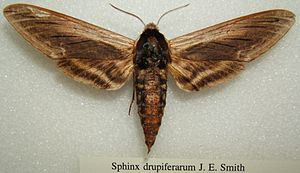Sphinx drupiferarum
| Sphinx drupiferarum | ||||||||||||
|---|---|---|---|---|---|---|---|---|---|---|---|---|

Sphinx drupiferarum (preparation) |
||||||||||||
| Systematics | ||||||||||||
|
||||||||||||
| Scientific name | ||||||||||||
| Sphinx drupiferarum | ||||||||||||
| JE Smith , 1797 |
Sphinx Drupiferarum is a butterfly ( moth ) from the family of moth (Sphingidae). The species is distributed in large parts of North America.
features
The moths have a fore wing length of 45 to 52 millimeters. Compared to other species of the genus Sphinx, they are characterized by clearly contrasting front wings. The forewings are slate gray with fine black median lines. The wavy, dark sub-terminal line is indistinct and bordered with a white and a whitish line in the terminal area, both of which run parallel to the outer edge. There is a broad, light gray, often almost white band on about three-quarters of the inner part of the costal margin. The medial area is almost black and extends as a very wide band from the inner edge to the wing tip. Sphinx perelegans is similar to the species, but the dark band of Sphinx drupiferarum is clearly stronger and more sharply defined. The proportion of light-colored scales in the costal area of the forewings is somewhat variable, so that there are also somewhat paler-colored animals.
The fully grown caterpillars are green and have seven sloping, white side stripes, which are bordered purple towards the back and thus give them a resemblance to the caterpillars of Sphinx gordius and Sphinx luscitiosa . One can easily distinguish the species from the similar species by the much wider violet borders on the side stripes, a pair of conspicuous black lines on the head and its reddish-purple anal horn .
The doll is very dark red-brown and has a slightly rough surface. Their very short proboscis sheath is exposed and lies close to the body. The wide cremaster is short and ends in a double point.
Occurrence
The species is distributed across much of North America, but is more common in the north. In the United States, the species is common from New England, the region around the Great Lakes and the Rocky Mountain States, north to the Pacific coast in northern California. To the south there is scattered evidence from northern South Carolina, Georgia, and Mississippi, as well as western central Texas. In Canada, with the exception of the maritime provinces, the species is distributed along its entire length from east to west, but it is rare in the prairie provinces. The species has been found in Nova Scotia, New Brunswick, southern Québec, Ontario, southern Manitoba, Saskatchewan, Alberta and British Columbia.
It is not easy to assign Sphinx drupiferarum to certain habitats, but the species prefers to colonize forest areas.
Way of life
The moths fly to light sources and also visit nectar plants. They are found on Lonicera japonica and pollinators of the rare orchid Platanthera praeclara .
Flight and caterpillar times
The moths fly in large parts of the range from mid-May to the end of July, in Utah the species only flies from the end of May. It is believed that the species only flies one generation per year anywhere.
Food of the caterpillars
The caterpillars eat a number of rose plants (Rosaceae), in particular Prunus species, apples ( Malus ) and rock pears ( Amelanchier ). However, it has also been proven in hackberry trees ( Celtis ) from the elm family (Ulmaceae).
development
The females lay their eggs individually on both sides of the leaves of the host plants. The caterpillars are nocturnal and hide during the day. Pupation takes place in a deep chamber in the ground.
supporting documents
Individual evidence
- ↑ a b c d e f g h i j k James P. Tuttle: The Hawkmoths of North America, A Natural History Study of the Sphingidae of the United States and Canada. The Wedge Entomological Research Foundation, Washington, DC 2007, ISBN 978-0-9796633-0-7 .
- ↑ a b Sphingidae of the Americas. Bill Oehlke, accessed December 30, 2011 .
literature
- James P. Tuttle: The Hawkmoths of North America, A Natural History Study of the Sphingidae of the United States and Canada. The Wedge Entomological Research Foundation, Washington, DC 2007, ISBN 978-0-9796633-0-7 .